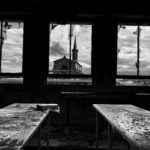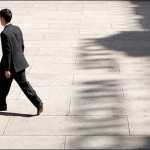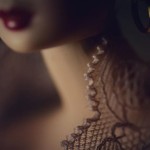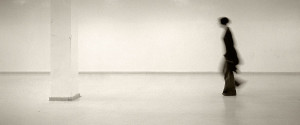This interview was conducted by Valeria Cammareri @_soulkitchen_ and Marina Torchiana @gatta_randagia
Elegant images in pastel tones, shots taken in the street though showing neither people nor aspects of daily life. An essential vision looking for harmony: the lines of a wall or a convertible top are all elements that sometimes cross in a drawing to make the common become artistry. These images are the result of a weighted search for geometries converging to create an abstract painting, where often there fits a human being or his shadow for decorative purposes. Everything perfectly balanced and nothing left to chance, and long waits for the missing character: this is Juan Sebastián Alcalá Ortiz, @__circo on Instagram.
We have asked him to share with us how he creates these extraordinary shots.
Tell us a little bit about yourself.
My name is Juan Sebastián Alcalá Ortiz and I live in Madrid, Spain. I earned a degree in law and I work in public administration. One of my favorite hobbies is taking my folding bike and my camera to wander in Madrid, trying to take some shots I like. Cycling, apart from being a great fun, also allows you to get to many places so that if you “see” a shot you just stop and shoot without the problems of parking. It’s a good combo.
Why “circo”? In Spanish, the informal use of the word “circo” means chaos, while everything in your images shows order and the utmost care for composition.
The name “circo” is totally accidental. I had decided to restart on Instagram and when the moment came for choosing my name, it occurred to me from the shot taken that day with the word “circo”: the first one in my account. With the benefit of hindsight I’ll tell you that inside circuses there are clowns, and I like to be a little bit of a clown sometimes.

Your current Instagram account features one hundred photos, and the first image dates back to about 12 weeks ago — though it is clear you are neither an inexperienced photographer nor a neophyte of the community. When and how did your photography journey begin? And how long have you been an Instagram user?
I discovered photography when i was 31, in 1992 (if you count… well, better not). It coincided with our son’s birth. I borrowed a Praktica camera, with a 50mm lens, to take the first shots of him; and at that very moment I discovered shutter speed, aperture, ISO and…. I’ve been enamored with photography to this day. I’m a self-taught photographer: I assembled a black and white photo laboratory at home, made the jump to the medium format, and joined the Royal Photographic Society of Madrid, where I’ve met great photographers, done some exhibitions, and received some awards (though few). Then arrived digital and iPhone photography, and with this last one I came into Instagram in 2014.

On your Instagram profile we read: 100 photos. That means you’ll be closing the account when you get 100 images, or are you planning to delete one shot each time you add a new one?
With the current Instagram account I wanted to do an album online, collecting in it 100 images. However it is a living album: images go in and out. The condition is this: that I like the shot going in more than the one going out. As a matter of fact I’m immersed in a deep creative crisis. I almost don’t have any time to shoot and I’m lacking the needed serenity to withdraw from personal matters occurring in this last year, to start again and sharpen my eye. Apart from that I’m OK and I have decided to create this album with 100 images with shots taken from my archive as well as the few new ones as I go along shooting. But the condition is what I told you: I must like the new image more than the one I’m removing. If I would start shooting images I like, maybe I could eliminate the limit of 100 photographs. Everything can be revised.
You mostly shoot urban environments and street scenes, though both places and people are unrecognizable and undefined. What draws you to this kind of photography?
I like simple shots, with few elements, including lines, spaces, geometrical blocks, more or less explicit. And people. I have a passion for shadows. I shoot in the streets but I don’t consider myself a street photographer. I like street photography, but it’s too difficult for me: I’m not able to do it. People in my images are one more element in the composition (a further part of the composition). For this reason they take little room, or I use a very low shutter speed to shoot them in partial movement. They are, anyway, a very important element of the composition: it’s completely out of the question, for example, backpacks and plastic bags. The color of clothing must fit the rest of the scene, even the age or the appearance. I got to the point of imagining the person I need in a given time, waiting for him (sometimes more than one hour), full of optimism that someone appears around, and sometimes I was lucky and was able to take the shot. Other times I had to go back to the same place and after various attempts, had to give up, as who I was waiting for didn’t show up.
Your work has a minimalist style . Has it been always your photographic language or is it a recent choice?
There was a time I used to shoot many portraits with a medium format camera. Environmental portraits, people (mainly artists of Madrid Academy of Art), in their places of work and study. Probably, that was the photographic period in which i felt most realized. It ended with a personal exhibition of Baryta prints I had processed. It was fantastic. In that occasion I felt Arnold Newman’s or Cartier Bresson’s influence. Afterwards I started with the photography you see currently. My preferred photographers today are: in Spain, Juan Manuel Castro Prieto; out of Spain, the great Koudelka and in Instagram Zerdzai Witworasakul.
In most of your street images prevails a feel of distance and detachment from reality. Is that process conscious or not?
I’m a very individualistic person: teamwork is not my strong point. I’m a loner and I enjoy solitude (within limits, of course) and maybe that is reflected in my shots. I think the feel of solitude is present in people and spaces I shoot. Anyway it is not a negative solitude but a pleasant one, a “solitude in peace”.

What kind of techniques do you use to create this look and feel of suspended atmosphere ?
Technical aspects:
Cameras: currently iPhone 5 (with ProCamera or Hipstamatic), Sony Nex 6 and Sony A7II. Until a few months ago I have been using a Sony RX 1 but I sold it in order to buy the A7II. I wanted a stabilizer of images to get moving shapes on sharp backgrounds shooting at 1/8 or 1/15. .
Editing: Adobe Photoshop, Snapseed, Squaready. Previously I used different apps (Noir, LoMob, etc.) , but by this time I have uninstalled them. My editing is simple: I do the same things I used to do in my laboratory, but with different tools.
What does the online Instagram community mean to you and what effect has it had on your photography?
My relationship with Instagram is a relationship of love/ hate. Firstly I have learned a lot since I have been here. I’m revising and re-editing many of the shots taken before Instagram and I think they are better now. Furthermore, I have met many good photographers and I enjoy their works. Though the social side in a few situations weighs heavily on me, overwhelms me, I don’t know how to handle it correctly. That’s the reason why I have already created many accounts and closed them. But I understood that in the end I come back, so i’ll try to control my impulses and not delete the current account.
Can you briefly explain the story and editing process behind your three favorite photos?
1- Silhouette in Gran Via– This shot was taken with iPhone 5. I was going to work on a bike very soon and saw this light so wonderful. From a few meters away there was this man coming closer. I couldn’t believe that. This trim figure, in a black suit for my white wall. Click.
2- A second in a mall – I shot this one in an overcrowded mall. It was like a break inside the confusion, a second of solitude. Taken with Sony RX 1.
3- Woman in the shadow – A very hot midday summer, close to the Madrid’s museum Reina Sofia . A sitting woman taking the opportunity of the little shadow of the square, alone, pensive. At peace?
Taken, I think, with Sony Nex 5
In your answers I found the recurrence of the word “peace”. The first occasion is when you talk to us of your solitude “in peace”, the second one is when after taking the shot of a woman sitting alone in the shadow you ask yourself if she was “at peace” or not. I have the feeling that “peace” is the thread of this interview…
The truth is I’m feeling quite overwhelmed with attempts to sort out a few family matters. You can easily imagine what I desire most is peace. When I can go out and take shots (more and more, less often) I forget everything, I feel in peace, even for just a few hours. I wonder if this is the reason I take “simple” shots, with few elements, easily digestible. Anyway for the rest, I’m ok and happy. You don’t have to think of me as a person living in misery or suffering. I feel just a little bit overwhelmed .

Where can we see your photography?
On Instagram I am @__circo
And you can find my pictures in a couple of places:
http://www.mamuga.com/late0329.htm
http://www.rsf.es/index.php?option=com_content&task=view&id=2&Itemid=22
Soledad en paz, por Valeria Cammareri y Marina Torchiana
Elegantes imagines en tono pastel, fotografías tomadas en la calle que sin embargo no representan ni personas ni tampoco escenas de vida cotidiana. Una visión esencial en busca de armonía : las líneas de una pared o los del techos de un coche, todos son elementos que a veces se cruzan en un dibujo para convertir un hecho común en obra de arte. Estas fotografías son el resultado de una cuidadosa investigación de geometrías que concurren para crear una pintura abstracta en la que a menudo se pone a un ser humano o su sombra con fines decorativos. Todo perfectamente equilibrado, nada dejado al azar, y largas esperas de un personaje que falta: este es Juan Sebastián Alcalá Ortiz, Circo en Instagram .
Le hemos preguntado qué comparta con nosotros su arte de crear tan extraordinarios momentos.
Cuentanos algo sobre de tí
Me llamo Juan Sebastián Alcalá Ortiz y vivo en Madrid (España). Soy licenciado en Derecho y trabajo en la Administración Pública. Una de mis aficiones es coger mi bicicleta plegable y mi cámara de fotos y salir por Madrid a intentar hacer alguna foto que me guste. La bicicleta, además de ser muy divertida, te permite desplazarte por muchos lugares y si ves una foto, paras y la haces sin problemas de aparcamiento. Son una buena combinación.
¿por qué ” circo “? . En el uso coloquial , la palabra ” circo ” tiene el sentido de confusión , desorden, caos y al revés todo en tus imagines es orden y gran cuidado en la composición
El nombre de circo es algo accidental. Decidí iniciar una nueva etapa en Instagram y cuando llegó el momento de elegir un nombre me vino a la mente la foto que acabada de hacer ese mismo día con la palabra circo, la primera de mi cuenta. Ya a posteriori te diré que en los circos hay payasos y a mi me gusta a veces ser un poco payaso ja ja ja.
Tú account Instagram actual tiene como cien fotos y la primera es de hace 12 semanas. A pesar de eso está claro que no eres un fotógrafo principiante y tampoco un neófito de la comunidad. ¿Cuándo y cómo ha nacido tu pasión por la fotografía ? ¿ Y desde cuándo estás en Instagram ?
Descubrí la fotografía cuando tenía 31 años, en 1992 ( si echas cuentas…buf, mejor no). Coincidió con el nacimiento de nuestro hijo. Me prestaron una cámara Praktica, con un 50 mm de rosca, para hacerle sus primeras fotos y en ese momento descubrí eso de las velocidades de obturación, la apertura del diafragma el ISO… Y quedé enganchado a la fotografía hasta hoy. Mi formación fue autodidacta, monté un laboratorio químico en blanco y negro en mi casa, di el salto al formato medio, me hice socio de la Real Sociedad Fotográfica de Madrid, donde conocí a grandes fotógrafos, alguna exposición, algún premio también ( pero pocos je je), luego vino el digital y el iphone 5 y con él entré en Instagram, en 2014.
En tu perfil de Istagram se lee : 100 fotos. Quiere decir que llegado a cien vas a cerrar el account o es que vas a quitar una cada vez que vas a poner una nueva ?
Con la cuenta actual de Instagram he querido hacer un álbum on line, reunir en él 100 fotos. Pero es un álbum vivo, entran y salen fotos. La condición es que la foto que entre me guste más que la que salga. En realidad me encuentro inmerso en una crisis creativa profunda. Casi no tengo tiempo para hacer fotos y me falta la tranquilidad necesaria para abstraerme de los problemas personales que me han surgido desde hace un año y volver a afinar el ojo. Por lo demás estoy bien y he decidido hacer ese álbum de cien fotos. Con fotos de mi archivo y las pocas nuevas que voy haciendo. Pero con la condición que te dije: la nueva foto tiene que gustarme más que la que quite. Si empiezo a hacer fotos que me gusten tal vez suprima el límite de cien fotos. Todo es revisable je je.
Tus imagines retratan generalmente entornos urbanos y escenas de la calle pero tan los lugares como las personas son irreconocibles e indefinibles. ¿Qué es lo que te atrae en este genero de fotografía ?
Me gustan las fotos sencillas, con pocos elementos, que incluyan líneas, espacios, bloques geométricos más o menos explícitos y personas. Las sombras me apasionan. Hago las fotos en las calles, pero no me considero un fotógrafo de reportaje (streetphotographer). Me encanta ver fotografía street, pero es demasiado difícil para mi, no se hacerla. Las personas en mis fotos son un elemento más de la composición. Por eso ocupan pequeños espacios o utilizo velocidades de obturación lentas para sacarlas parcialmente movidas. Pero son un elemento de composición importantísimo y no vale cualquiera: nada de mochilas, bolsas de plástico; el color de su ropa debe encajar con el resto de la escena, incluso su edad y apariencia externa. He llegado a imaginar la persona que necesitaría en un momento dado y esperar ( en ocasiones más de una hora) cargado de optimismo a que apareciera por allí, y a veces he tenido suerte y he hecho la foto. Otras he tenido que volver al mismo sitio y tras varios intentos desistir porque no llegó quien yo esperaba.
Tu trabajo tiene un estilo minimalista, qué sentido tiene para ti esta elección ? Siempre te has expresado así o se trata de un lenguaje recién elegido ?
Tuve un tiempo en que hice muchos retratos, con mi cámara de formato medio. Retratos de ambiente, personas ( sobre todo artistas de la Facultad de Bellas Artes de Madrid) en sus lugares de trabajo o estudio. Fue quizá el periodo fotográfico en el que me he sentido más realizado. Culminó con una exposición individual de los baritados que yo mismo positivé. Fue genial. Aquí sentí la influencia de Arnold Newman o Cartier Bresson.Luego empecé con la fotografía que actualmente muestro.Mis fotógrafos favoritos hoy son: en España Juan Manuel Castro Prieto, de fuera de España el gran Koudelka y de Instagram Zerdzai Witworasakul.
La mayoría de tus fotos son sacadas en la calle pero no retratan ni personas ni momentos de la vida de todos los días, lo que se percibe es una sensación de distancia y desapego / alejamiento de la realidad . ¿ Este efecto es algo buscado por tu parte o no?
Soy una persona muy individualista, lo de trabajar en equipo no es mi fuerte. Soy un solitario y disfruto de la soledad (con un límite, por supuesto). Quizá eso se refleje en mis fotos. La sensación de soledad creo que está presente en las personas y espacios que fotografío. Pero no es una soledad negativa, es una soledad placentera, una “soledad en paz””.
¿Cuáles son las técnicas que utilizas para crear esta atmósfera suspendida ? ( p.e. sombras, siluetas , blur, técnicas de edición …)
Cuestiones técnicas:
Cámaras: en la actualidad iPhone 5 (con procamera o hipstamatic) sony nex 6 y sony A7 II Hasta hace unos meses usaba la sony RX1 pero la vendí para comprar la A7II. Quería estabilizador de imagen para conseguir figuras movidas sobre fondos nítidos disparando a 1/8 o 1/15 de segundo a pulso.
Programas de edición: Adobe photoshop, snapseed, squaready. Antes usaba otras app ( noir, lo mob etc) pero ya las tengo desinstaladas. Ediciones sencillas, hago lo mismo que hacía en el laboratorio pero con herramientas distintas.
¿Quė sentido tiene para ti la comunidad de Instagram y cómo influyó sobre tu fotografía ?
Qué opino de Instagram. Mi relación con Instagram es una relación de amor/odio. En primer lugar he aprendido mucho desde que estoy aquí. Muchas de las fotos que tenía anteriores a instagram las estoy revisando y reeditando y creo que ahora son mejores. También he conocido muy buenos fotógrafos y disfruto viendo sus trabajos. Sin embargo, el aspecto “red social” en ocasiones me agobia, me atormenta, no se gestionarlo correctamente. Ese es el motivo por el que he creado ya varias cuentas y las he dado de baja. Pero ya he aprendido que al final vuelvo, así que intentaré controlar mis impulsos y no volver a borrar mi cuenta actual. Sobre todo no hay que tomarse esto muy en serio, solo un poquito:))
¿ Nos puedes explicar la historia y el editing de de las tres fotos tuyas que prefieres?
1. Silueta en la Gran Via . Esta fue tomada con el iPhone 5. Yo iba a trabajar en mi bici muy temprano y vi esa luz tan estupenda. A unos metros se acercaba este hombre. No me lo podía creer, esa figura alargada, vestido de negro para mi pared blanca. Clic
2.Un segundo en el Centro Comercial. Esta la hice en un centro comercial repleto. Fue un paréntesis en el bullicio, un segundo de soledad. Tomada con Sony rx1
3. Mujer a la sombra. Un mediodía de verano de mucho calor, junto al museo Reina Sofía de Madrid. Una mujer sentada aprovechando una de las pocas sombras de la plaza, sola, pensativa ¿en paz?
Tomada creo que con sony nex 5
Observo que en tus respuestas haces uso de la palabra “paz”, la primera en ocasión de tu “soledad en paz” , luego , después de sacarle una foto a la mujer sentada en la sombra te preguntas si ella está “en paz” o no. Tengo la impresión que ” paz” sea el hilo conductor de esta entrevista .
La verdad es que vivo bastante agobiado intentando solucionar los dificultades familiares. Te puedes imaginar que lo que mas deseo es la paz. Y cuando puedo salir a hacer fotos ( cada vez menos) me olvido de todo, me siento en paz, aunque solo sea unas horas.Quiza por eso haga fotos sencillas, con pocos elementos, faciles de digerir.Pero por lo demas me encuentro bien y feliz. No creas que vivo atormentado o sufriendo.Solo agobiado
¿Dónde podemos encontrar tus fotos?
En @instagram soy @__circo
Hay fotos mias en un par de enlaces :
http://www.mamuga.com/late0329.htm
http://www.rsf.es/index.php?option=com_content&task=view&id=2&Itemid=22
Los Autores de esta intervista son Valeria Cammareri @_soulkitchen_ y Marina Torchiana @gatta_randagia
About Author

- Since her childhood Valeria has been a storyteller: She used to invent musicals for puppets. Her parents would tease her as they perceived she magnified reality. What she liked was not to hide the truth but rather, to give more drama or beauty to the ordinary facts of her life. She wasn’t particularly fond of photography until October of 2013, when she created an account @_soulkitchen_ on Instagram, starting a diary of images. She is a contemplative, not interested in representing reality, but rather memories, desires, and the core of feminine beauty. If something captures her attention, or if she has an idea about, a story to tell, she immediately thinks of how to shift it from her imagination to an image.
Latest stories
 StoriesJuly 31, 2017Pas de deux, part 1
StoriesJuly 31, 2017Pas de deux, part 1 StoriesJuly 24, 2016Keep it Simple: an interview with Nei Cruz
StoriesJuly 24, 2016Keep it Simple: an interview with Nei Cruz StoriesApril 8, 2016Solitude in Peace: This is @__circo
StoriesApril 8, 2016Solitude in Peace: This is @__circo StoriesNovember 4, 2015Barbie’s secret life
StoriesNovember 4, 2015Barbie’s secret life












Gran trabajo, enhorabuena Juan Sebastián!!
Excelente entrevista, un placer leer la perspectiva e historia detras del quehacer fotográfico de un artista, ojala te quedes por mucho Juan Sebastian.